The mice will play – whether the cat’s away or no. In this week’s installment, the non-Mickey elite of rodentdom get into the travel craze, finding there’s more to the world than the inside of a mousehole. Cats of course will also tag along – including at least one seeking a more lightweight prey with yellow feathers. Dogs, too, will be represented by a talking canine with large buck teeth. Finally, to round out our parade of species, there’ll be ducks, bears, bulls, a wabbit, and even a human or two.
 Herman the Mouse and his circle of kinfolk may be more intent on relocation rather than temporary getaway, but since they always ultimately wind up back at the same mousehole, we’ll treat this one as an excursion. In Mice Paradise (Paramount/Famous, Noveltoon, 3/9/51 – I. Sparber, dir.), Cousin Herman drops in on his less fortunate relations as usual – and as usual finds them beleaguered by Katnip. But Herman has glad tidings to spread – his discovery in his travels of a tropical island, with plenty of eats, and “Hold on to your hats – no cats!” Herman bids them to “leave this hole in the wall.” Outside the mousehole Katnip overhears. “Oh no, you’re not”, he shouts. Reaching in to grab the rodents, Katnip finds only a snapping mousetrap, with an attached note: “Oh yes we are. So long, Sourpiss.” Our scene shifts to the tropical retreat, where not only the mice, but the swaying palms dance the hula. Herman spreads a fish luau feast, and the mice prepare to dig in. But an added treat appears in store, as the tide washes in a floating barrel, marked “champagne”. In reality, it is a Trojan horse, from which pops Katnip. Herman crowns the cat with a mallet he was about to use to tap the barrel, and the chase is on.
Herman the Mouse and his circle of kinfolk may be more intent on relocation rather than temporary getaway, but since they always ultimately wind up back at the same mousehole, we’ll treat this one as an excursion. In Mice Paradise (Paramount/Famous, Noveltoon, 3/9/51 – I. Sparber, dir.), Cousin Herman drops in on his less fortunate relations as usual – and as usual finds them beleaguered by Katnip. But Herman has glad tidings to spread – his discovery in his travels of a tropical island, with plenty of eats, and “Hold on to your hats – no cats!” Herman bids them to “leave this hole in the wall.” Outside the mousehole Katnip overhears. “Oh no, you’re not”, he shouts. Reaching in to grab the rodents, Katnip finds only a snapping mousetrap, with an attached note: “Oh yes we are. So long, Sourpiss.” Our scene shifts to the tropical retreat, where not only the mice, but the swaying palms dance the hula. Herman spreads a fish luau feast, and the mice prepare to dig in. But an added treat appears in store, as the tide washes in a floating barrel, marked “champagne”. In reality, it is a Trojan horse, from which pops Katnip. Herman crowns the cat with a mallet he was about to use to tap the barrel, and the chase is on.
Herman launches a crab (similar to Mickeys’ in Hawaiian Holiday) onto Katnip’s head, which takes a painful pinch on the cat’s nose. Katnip retaliates by launching the crab back at Herman – but Herman is ready, and surprises the audience by appearing from behind a tree, riding the crab like a polo pony, and smacking coconuts with a pole like polo balls back into the bulging jowls of Katnip. Heman next bides his time, smoking a cigar next to a giant clam on the beach. As Katnip arrives, Herman blows a dose of smoke into the clam’s shell to make him sneeze, and when the smoke clears has planted the incriminating cigar on Katnip. The angry clam “clam”ps down on Katnip, while Herman jacks up the two of them and dumps both into the sea. The mice celebrate – too soon – as Katnip somehow escapes the clam’s grip, and brings up from the sea a smaller model of the same shellfish to catch Herman’s cousins in. As the mice wail helplessly, Katnip sets to prepare a “Deep dish mouse pie – Hawaiian style”. He garnishes around the shell with fresh cut pineapple. Herman adds to the supply, with a “pineapple” of a different color – WWII surplus, small, black, and with a pin at the top. Katnip slices off the top, removing the grenade’s pin. BOOM! He lands in the middle of the bay atop a buoy – but is not alone. A shark, carrying knife and fork, awaits, leaving Katnip leaping from one side to the other to avoid the carnivore’s jaws. Safe on shore, Herman plays uke as his cousins hula against the sunset, as Herman serenades, “Farewell to you, This time you’re through. I knew you’d get it in the end.”
Seasick Sailors (Terrytoons, Little Roquefort, 7/1/51 – Mannie Davis, dir.) – For once, Roquefort gets the jump on Jerry Mouse, setting sail for adventure over a year before Jerry’s first voyage. Though, as typical of Terrytoons, a few elements of this episode might be said to take minimal inspiration from Herman’s Mice Paradise earlier in the year, or even from Pluto’s Dog Watch (1945), involving a ship-boarding rat. Our scene opens on a typical Percy-chases-Roquefort moment, with Roquefort escaping detection by posing as part of a book-end (an Atlas style sculpted figure appears to hold up the books, while Roquefort poses as if holding up Atlas). Roquefort spies on the same desk an open magazine ad – “Why not get away from it all? Come to Hawaii.” Why such an ad would depict a mouse hula girl remains a mystery, but Roquefort envisions himself joining her in the hula. As Percy trails behind him, Roquefort enters his mousehole and packs a suitcase. To clear the doorway of Percy’s prying eye, Roquefort shoots a water pistol in his face, then passes right by out the front door. A voice of Percy’s evil conscience tells him he can’t let Roquefort get away with this. If there’s no mice, there’ll be no need for a cat. So Percy races for the docks.
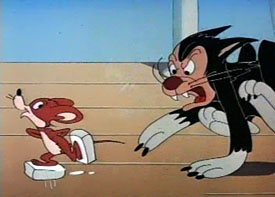 Arriving at the loading dock for the S.S. Hawaii ahead of Roquefort, Percy sets out a semicircle of mousetraps around the gangplank, and stands personal watch within their perimeter. Roquefort arrives, but despite Percy’s menacing glare, analyzes the situation with finesse. Standing atop the metal bar of one of the mousetraps, Roquefort activates the trigger mechanism – and is catapulted by the spring right past Percy, aloft onto the hawser rope extending from the dock to the ship. Percy races up the gangplank to the ship’s deck, and installs a metal rat guard on the mooring rope. Roquefort is more modern than the rat who encountered one of these in Pluto’s Dog Watch (who was so tough, her merely used his tail as a file to cut a hole through it), and carries in his suitcase a small blow torch, which neatly accomplishes the same purpose. He enters on deck through a ventilator funnel, not realizing that Percy is again one step ahead of him, waiting to receive him as he climbs down – right into Percy’s paw. Roquefort sets out a comfortable pillow and lounges as if on deck – then sees Percy’s chin high above him. He zips out of the frame, landing on two cakes of soap left next to a seaman’s pail and mop. Using the soap as a pair of skates, Roquefort literally swabs the deck as Percy pursues, finally toppling Percy by dumping the pail of water in his path.
Arriving at the loading dock for the S.S. Hawaii ahead of Roquefort, Percy sets out a semicircle of mousetraps around the gangplank, and stands personal watch within their perimeter. Roquefort arrives, but despite Percy’s menacing glare, analyzes the situation with finesse. Standing atop the metal bar of one of the mousetraps, Roquefort activates the trigger mechanism – and is catapulted by the spring right past Percy, aloft onto the hawser rope extending from the dock to the ship. Percy races up the gangplank to the ship’s deck, and installs a metal rat guard on the mooring rope. Roquefort is more modern than the rat who encountered one of these in Pluto’s Dog Watch (who was so tough, her merely used his tail as a file to cut a hole through it), and carries in his suitcase a small blow torch, which neatly accomplishes the same purpose. He enters on deck through a ventilator funnel, not realizing that Percy is again one step ahead of him, waiting to receive him as he climbs down – right into Percy’s paw. Roquefort sets out a comfortable pillow and lounges as if on deck – then sees Percy’s chin high above him. He zips out of the frame, landing on two cakes of soap left next to a seaman’s pail and mop. Using the soap as a pair of skates, Roquefort literally swabs the deck as Percy pursues, finally toppling Percy by dumping the pail of water in his path.
Roquefort next appears from within a coil of rope, holding a pair of binoculars to see if the coast is clear. As he pans his view across the deck, both lenses are filled by the glowering eyes of Percy, almost nose to nose with him. Roquefort’s fist emerges through one of the eyepieces, giving Percy a temporary “shiner”. Roquefort disappears, and Percy searches the deck, and then the cabins. While inside, he views through the porthole “rough seas” (simulated by Roquefort in old gag borrowed from Tex Avery’s Screwball Squirrel (1944), by holding up a cardboard cutout of ocean waves and moving it behind the hole). But Roquefort adds one twist on Avery – turning the cutout upside down, so that the waterline seems to float clear around the porthole.
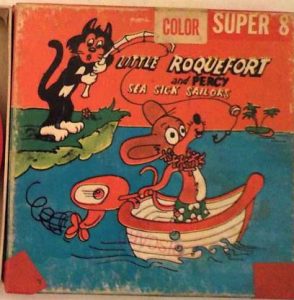 Inside, a seasick Percy, turning green, also circles the porthole, as if the ship were performing a somersault. After Percy recovers, the next sequence could only happen in a Terrytoon. Only here would a peacetime ocean liner still retain a deck artillery cannon and shells, looking as if they were left over from WWII. Roquefort climbs into the breech of the gun, and Percy slams it shut and lights the cannon’s fuse. Roquefort merely climbs out the other end, and turns the gun around to fire at Percy. Percy hits the front of the Captain’s bridge, and the ship’s whistle falls into Percy’s mouth, lodging in his tail. Despite the improbability of the idea, from the fact that the whistle is no longer attached to a steam source, a funny sight gag results as Roquefort jumps on the whistle’s valve handle protruding from Percy’s tail, causing Percy to spout seam from his mouth and hop like the sort of squeeze-bulb rabbit toy used in Donald Duck’s Donald’s Off Day (1944).
Inside, a seasick Percy, turning green, also circles the porthole, as if the ship were performing a somersault. After Percy recovers, the next sequence could only happen in a Terrytoon. Only here would a peacetime ocean liner still retain a deck artillery cannon and shells, looking as if they were left over from WWII. Roquefort climbs into the breech of the gun, and Percy slams it shut and lights the cannon’s fuse. Roquefort merely climbs out the other end, and turns the gun around to fire at Percy. Percy hits the front of the Captain’s bridge, and the ship’s whistle falls into Percy’s mouth, lodging in his tail. Despite the improbability of the idea, from the fact that the whistle is no longer attached to a steam source, a funny sight gag results as Roquefort jumps on the whistle’s valve handle protruding from Percy’s tail, causing Percy to spout seam from his mouth and hop like the sort of squeeze-bulb rabbit toy used in Donald Duck’s Donald’s Off Day (1944).
Roquefort “hops” Percy into a staircase leading down to the engine room, where Percy tumbles downstairs, and rises to find himself standing under a large U-shaped drive mechanism for the ship’s engine. Roquefort starts the engine building steam, and the huge bar slowly descends, causing Percy to hop over it. The engine gains momentum, causing Percy to take faster and faster leaps. Roquefort shifts the handle of an “engine order telegraph” to Full Speed Ahead – and Percy competes for the title of world’s champion jump-roper, until the speed of the bar is just too much for him. He is batted upwards through the deck, and overboard into the sea. Roquefort tosses him a life preserver attached to a rope, and relaxes on deck for a peaceful voyage, while the preserver is towed a few hundred feet astern of the ship, with Percy destined to remain there for the rest of the voyage, as several seagulls join him as passengers, and one builds a nest atop his head.
Tweety’s S.O.S. (Warner, Tweety and Sylvester, 9/22/51 – I. (Friz) Freleng, dir.) – Food connoisseur Sylvester carefully selects his dinner ingredients cafeteria-style from a row of local trash cans, then pauses to savor their aroma. One whiff, and he dumps the whole mess back in the trash, and sulks hungrily along the docks. Through the porthole of a lower cabin on a moored ocean liner, Sylvester spots – you know who – a yellow canary swinging on his perch in a cage. “Hello, breakfast”, says Sylvester in formal greeting. Tweety slams the porthole window in his face, dumping the cat into the bay. He climbs out of the water, and disgustedly bats a crab off his tail. Sneaking on board, he intrudes into the cabin, but comes face to face with Granny, who swats a mean umbrella. Despite temporarily losing her glasses (retrieved in the nick of time by Tweety), Granny chases Sylvester down the gangplank, scoring a direct hit on his head with a long-distance throw of the umbrella. However, as the ship sets sail, with Granny and Tweety waving goodbye from the deck, Sylvester also waves goodbye – from under the tarpaulin of lifeboat number 13.
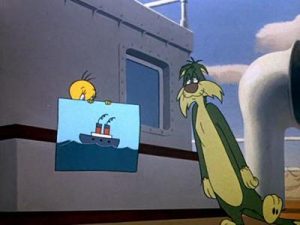 As Granny and Tweety relax in lounge chair and cage, respectively, Sylvester plays on Granny’s need for spectacles, by borrowing her glasses while she sleeps, and painting an image of Tweety on one lens. Placing the glasses back where Granny had laid them, he slips quietly to the cage and grabs Tweety. Despite Tweety’s cries, Granny puts on her glasses, looks to the cage – and sees a badly-drawn Tweety safe and sound. The chase covers various areas of the ship, including a high-wire act on the ship’s radio aerial (Tweety “helpfully” releasing Sylvester’s grip finger by finger from being “all caught up in the wire”), and a chase through multiple hatch doorways, ending with Sylvester opening one too many doors and running into the ship’s boiler, emerging with a scream out the smokestack. A running gag has Sylvester turning green from the ship’s motion. Tweety helpfully suggests he put something on his stomach – like a nice piece of salt pork. This causes Sylvester to run to the ship’s dispensary, and take a heaping dose of seasick medicine. Tweety induces more turning green with the old move the picture up and down waves gag again, but this time, before Sylvester can reach the dispensary, Tweety spikes the seasick medicine with an added dose of nitro glycerin. As Sylvester drinks, Tweety encourages him to drink it all down – and Sylvester suspect skullduggery. He spits a drop on the floor, and it ignites in a little fireball. Sylvester sees possibilities in this, and uses his new found power as a weapon, pursuing Tweety, spitting explosive balls at him as he runs. Sylvester rounds a corner – and finds himself face to face with Granny again. “Still around, eh? Well take that!”, she says, as she starts swatting with the umbrella. “No no, Gwanny. Don’t hit him! Youw’ll be sowwy!”, says Tweety. BOOM!!! A somewhat charred Granny stands perplexed, as Sylvester soars into the skies like a signal flare, then plummets back to the deck. The captain makes a cameo appearance, looking skywatd with his binoculars, saying, “I taut I taw a putty tat.” Sylvester lands atop him, coming to rest around the captain’s neck. On the bridge, a recovered Granny and Tweety don admiral and sailor hats, respectively, taking the wheel, and informing the captain, “You did. You did tee a putty tat!”
As Granny and Tweety relax in lounge chair and cage, respectively, Sylvester plays on Granny’s need for spectacles, by borrowing her glasses while she sleeps, and painting an image of Tweety on one lens. Placing the glasses back where Granny had laid them, he slips quietly to the cage and grabs Tweety. Despite Tweety’s cries, Granny puts on her glasses, looks to the cage – and sees a badly-drawn Tweety safe and sound. The chase covers various areas of the ship, including a high-wire act on the ship’s radio aerial (Tweety “helpfully” releasing Sylvester’s grip finger by finger from being “all caught up in the wire”), and a chase through multiple hatch doorways, ending with Sylvester opening one too many doors and running into the ship’s boiler, emerging with a scream out the smokestack. A running gag has Sylvester turning green from the ship’s motion. Tweety helpfully suggests he put something on his stomach – like a nice piece of salt pork. This causes Sylvester to run to the ship’s dispensary, and take a heaping dose of seasick medicine. Tweety induces more turning green with the old move the picture up and down waves gag again, but this time, before Sylvester can reach the dispensary, Tweety spikes the seasick medicine with an added dose of nitro glycerin. As Sylvester drinks, Tweety encourages him to drink it all down – and Sylvester suspect skullduggery. He spits a drop on the floor, and it ignites in a little fireball. Sylvester sees possibilities in this, and uses his new found power as a weapon, pursuing Tweety, spitting explosive balls at him as he runs. Sylvester rounds a corner – and finds himself face to face with Granny again. “Still around, eh? Well take that!”, she says, as she starts swatting with the umbrella. “No no, Gwanny. Don’t hit him! Youw’ll be sowwy!”, says Tweety. BOOM!!! A somewhat charred Granny stands perplexed, as Sylvester soars into the skies like a signal flare, then plummets back to the deck. The captain makes a cameo appearance, looking skywatd with his binoculars, saying, “I taut I taw a putty tat.” Sylvester lands atop him, coming to rest around the captain’s neck. On the bridge, a recovered Granny and Tweety don admiral and sailor hats, respectively, taking the wheel, and informing the captain, “You did. You did tee a putty tat!”
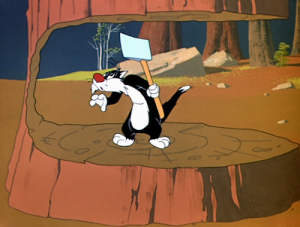 Tweet Tweet Tweety (Warner, Tweety and Sylvester, 12/15/51 – I. (Friz) Freleng, dir,) – With no Granny to bother him this time. Sylvester vacations in a trailer camp at a national park, as a pampered pet with his own exit door out the side of the trailer. The chirping of the native wildlife arouses Sylvester’s baser instincts, but a watchful ranger trips up his entry into the woods, telling him not to get any ideas, as a sign indicates this is a bird and game refuge. Has this ever stopped Sylvester? Of course not. At his first opportunity, Sylvester is out on a limb to raid a nest. But instead of a bird, he finds only an egg. “I’ll hatch it out”, he decides. A longer process than he envisioned, leaving Sylvester struggling to keep his sleepy eyes open. Unnoticed below, the egg hatches, as Tweety pops his head out from under the cat’s posterior, delivering his signature “Putty tat” line. He is unable to get out from underneath, and formulates his course of action. “I gotta think of a way to get that putty up offa me.” Producing from nowhere a sharp pin, Tweety concludes, “I thinked it.” A painful “Yeow” from the cat results from his efforts. “I can tell he don’t wike me”, Tweety observes.
Tweet Tweet Tweety (Warner, Tweety and Sylvester, 12/15/51 – I. (Friz) Freleng, dir,) – With no Granny to bother him this time. Sylvester vacations in a trailer camp at a national park, as a pampered pet with his own exit door out the side of the trailer. The chirping of the native wildlife arouses Sylvester’s baser instincts, but a watchful ranger trips up his entry into the woods, telling him not to get any ideas, as a sign indicates this is a bird and game refuge. Has this ever stopped Sylvester? Of course not. At his first opportunity, Sylvester is out on a limb to raid a nest. But instead of a bird, he finds only an egg. “I’ll hatch it out”, he decides. A longer process than he envisioned, leaving Sylvester struggling to keep his sleepy eyes open. Unnoticed below, the egg hatches, as Tweety pops his head out from under the cat’s posterior, delivering his signature “Putty tat” line. He is unable to get out from underneath, and formulates his course of action. “I gotta think of a way to get that putty up offa me.” Producing from nowhere a sharp pin, Tweety concludes, “I thinked it.” A painful “Yeow” from the cat results from his efforts. “I can tell he don’t wike me”, Tweety observes.
Typical gags round out most of the film. Sylvester uses a bicycle pump in a tree hole to force Tweety out another hole in the limb, but pumps out a firecracker instead. He tries to chop down the tree, and repeats Freleng’s gag from Buccaneer Bunny of standing within the chopped-out portion of the trunk, only to have it collapse on him straight down. Sylvester tries a flying trapeze to reach Tweety, but swings too close to a bridge builder’s pile driver with expected results. A final sequence has Tweety row down the river on a log, while Sylvester follows in a rowboat. They both head for a waterfall over a hydroelectric dam. Tweety’s log floats over the gateway and down, but Tweety jumps onto the dam structure in the nick of time. Sylvester’s boat goes straight over before he realizes where he is, then he flips the boat around and furiously rows uphill against gravity. He seems about to reach the top, when Tweety decides to “help” by turning a valve. The mechanism shuts off the gateway, and the flow of water, entirely, leaving Sylvester and ship in mid-air. A wave bye-bye, and Sylvester falls with a crash. Tweety’s curtain line: “Y’know, dat putty tat gonna hurt heself if he not more careful.”
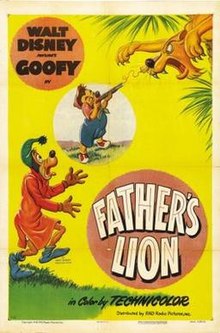 Father’s Lion (Disney/RKO, Goofy, 1/4/52 – Jack Kinney, dir. Long before Goof Troop and Max, everyman Goofy (frequently referred to as George Geef) acquired a son in “Fathers are People” (1951). The passage of a year has increased father-son bonding, so that Geef is now the object of hero-worship by his offspring – and playing this advantage to the hilt. He fills his son’s head with wild tall tales of having driven Western stagecoaches, hunted on big game safaris (accompanied by brief film clips from Californy ‘er Bust, Tiger Trouble, and African Diary, all from 1945), and led parties up the Matterhorn. (How, Geef? Disneyland hasn’t even been built yet!) But most of all, he attests to knowing everything there is to know about roughing it in the great outdoors, setting out on a camping trip with Junior (who gullibly believes his every word).
Father’s Lion (Disney/RKO, Goofy, 1/4/52 – Jack Kinney, dir. Long before Goof Troop and Max, everyman Goofy (frequently referred to as George Geef) acquired a son in “Fathers are People” (1951). The passage of a year has increased father-son bonding, so that Geef is now the object of hero-worship by his offspring – and playing this advantage to the hilt. He fills his son’s head with wild tall tales of having driven Western stagecoaches, hunted on big game safaris (accompanied by brief film clips from Californy ‘er Bust, Tiger Trouble, and African Diary, all from 1945), and led parties up the Matterhorn. (How, Geef? Disneyland hasn’t even been built yet!) But most of all, he attests to knowing everything there is to know about roughing it in the great outdoors, setting out on a camping trip with Junior (who gullibly believes his every word).
In the mountains, a lion is seen dodging bullet fire. But he’s not the intended target. It’s merely Geef, demonstrating his marksmanship with a tossed-up tin can (which he missed entirely, the only holes in the can being from the opener). Geef sets up camp, and (as in Pluto’s “Camp Dog” reviewed last week) decides to hang up their meat supply from the trees to keep it from the forest creatures. The effort is a futile one, as he ties a ham not to a branch or vine, but to the hanging tail of the lion on a limb above, who gets a surprise free meal. Observant Junior spots the beast, and asks Dad if there are any lions around here. “Nope”, says Geef, still absent-mindedly reaching for anything he thinks is an outgrowth of the tree – who again grabs hold of the lion’s tail. Without ever looking over his shoulder, Geef uses what is in his hand for a demonstration: “If these was, I’d grab him by the tail, and swing him around, then twist his arm. Then I’d jump on him, and give him the old heave-ho!” Unbeknownst to him, he has just accomplished, for the first time in his life, one of his fabled feats, as the lion lays in a daze, seeing stars, and Geef rises several notches in esteem in the eyes of his son. The lion recovers, and creeps up on the campfire Geef is making – only to have Geef blow smoke in his face. As Geef brags of having been known as Sourdough Joe, best flaphack maker in the West, he flips some of such breakfast items in a pan. One of them rises to the tree limb above, where the lion has returned, and the lion hungrily swallows it. Geef’s cooking can hardly be called light and fluffy, as the pancake descends like a lead weight in the lion’s belly, causing the tree limb to crack and fall, leaving the lion walking off limping, using his tail as a crutch.
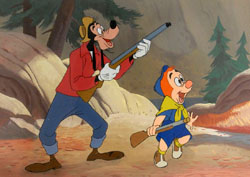 Night falls, and father and son ready their sleeping bags. Junior asks for a drink of water, and sleepy Geef nearly misses a slash from the lion, who is also at the water hole. The lion decides to try for revenge on Geef by slipping into his sleeping bag. Geef attempts to step in, mistaking the open jaws of the lion for the opening in the bag, and is halfway to pulling himself into being swallowed alive, when Junior reminds Pop they haven’t said their prayers. The lion grumbles as Geef steps our of danger and joins Junior in prayer, but is heartened when he hears Junior name him among persons included in his blessings. Geef returns to the sleeping bag, where Junior spots the lion’s tail protruding. “Daddy, do lion’s sleep in sleeping bags?”, Junior inquires. Half asleep, Geef replies, “Oh, sure, sure…” and slips one leg into the bag, pushing the lion’s leg in the process, so that the lion’s claws tear a hole in the bag. Geef mistakes the claws for his own toenails, and clips them with a clipper before pulling up the bag’s zipper. “Yeow!!’, screams the lion, as Geef has caught the beast’s tail in the zipper. The secret is out, and Geef reaches for a shotgun – but only gets Junior’s popgun handed to him instead. It at least produces a diversion, as the lion takes a cork in the nose, making him sneeze. Finding the real gun, Geef takes a pot-shot at the lion which misses widely, and the lion hides behind one of a pair of trees. Geef pursues to keep up illusions of greatness, but ducks behind the other tree. When Junior tells him “Not this tree, that one”, Geef, in bravura cowardice, shouts, “Never you mind! I’m checkin’ this one first!” As Geef pauses, the jaws of the lion slowly descend over his head from a limb above. “I gotcha”, says Geef, raising the rifle and pointing it directly at the lion’s head over his own. The lion jumps back to the tree limb, leaving Geef staring down the barrel of his own gun, as he ducks to narrowly miss the emerging shot. The lion chases Geef furiously around the camp, but a well-timed shot by Junior with his popgun sets the lion into another sneeze, causing him to stumble and get rolled up in Geef’s sleeping bag. Seeing no sign of the beast, Geef thinks he eluded him, and rapidly breaks camp – taking the sleeping bag with him. Back at the car, Junior cheers Pop on how he almost caught that old lion. Thinking himself out of danger, Geef reverts to bragging again, repeating verbatim his earlier boasts of what he’d do if he had gotten his hands on the beast – missing again entirely that he is really performing the beating on the lion, who has just emerged from the sleeping bag. The lion rises from the buffeting with anther fierce snarl, and is finally noticed by Geef, who grabs Junior, leaps into the car, and exits at top speed. Covering neatly for his chicken-hearted exhibition of self-preservation, Geef, clinging to the steering wheel, spins his next tall tale. “Did I ever tell you about the time I was a race driver?”
Night falls, and father and son ready their sleeping bags. Junior asks for a drink of water, and sleepy Geef nearly misses a slash from the lion, who is also at the water hole. The lion decides to try for revenge on Geef by slipping into his sleeping bag. Geef attempts to step in, mistaking the open jaws of the lion for the opening in the bag, and is halfway to pulling himself into being swallowed alive, when Junior reminds Pop they haven’t said their prayers. The lion grumbles as Geef steps our of danger and joins Junior in prayer, but is heartened when he hears Junior name him among persons included in his blessings. Geef returns to the sleeping bag, where Junior spots the lion’s tail protruding. “Daddy, do lion’s sleep in sleeping bags?”, Junior inquires. Half asleep, Geef replies, “Oh, sure, sure…” and slips one leg into the bag, pushing the lion’s leg in the process, so that the lion’s claws tear a hole in the bag. Geef mistakes the claws for his own toenails, and clips them with a clipper before pulling up the bag’s zipper. “Yeow!!’, screams the lion, as Geef has caught the beast’s tail in the zipper. The secret is out, and Geef reaches for a shotgun – but only gets Junior’s popgun handed to him instead. It at least produces a diversion, as the lion takes a cork in the nose, making him sneeze. Finding the real gun, Geef takes a pot-shot at the lion which misses widely, and the lion hides behind one of a pair of trees. Geef pursues to keep up illusions of greatness, but ducks behind the other tree. When Junior tells him “Not this tree, that one”, Geef, in bravura cowardice, shouts, “Never you mind! I’m checkin’ this one first!” As Geef pauses, the jaws of the lion slowly descend over his head from a limb above. “I gotcha”, says Geef, raising the rifle and pointing it directly at the lion’s head over his own. The lion jumps back to the tree limb, leaving Geef staring down the barrel of his own gun, as he ducks to narrowly miss the emerging shot. The lion chases Geef furiously around the camp, but a well-timed shot by Junior with his popgun sets the lion into another sneeze, causing him to stumble and get rolled up in Geef’s sleeping bag. Seeing no sign of the beast, Geef thinks he eluded him, and rapidly breaks camp – taking the sleeping bag with him. Back at the car, Junior cheers Pop on how he almost caught that old lion. Thinking himself out of danger, Geef reverts to bragging again, repeating verbatim his earlier boasts of what he’d do if he had gotten his hands on the beast – missing again entirely that he is really performing the beating on the lion, who has just emerged from the sleeping bag. The lion rises from the buffeting with anther fierce snarl, and is finally noticed by Geef, who grabs Junior, leaps into the car, and exits at top speed. Covering neatly for his chicken-hearted exhibition of self-preservation, Geef, clinging to the steering wheel, spins his next tall tale. “Did I ever tell you about the time I was a race driver?”
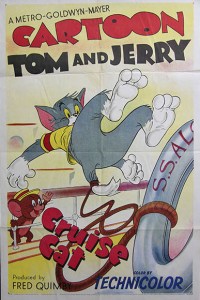 Cruise Cat (MGM, Tom and Jerry, 10/18/52 – William Hanna/Joseph Barbera, dir.) – Jerry Mouse finally gets a vacation, though for Tom it’s a working holiday. Their troubles aboard the S.S. Aloha are lively but not of the highest originality of the series – in fact, the writers fall short of material, and resort to use of an extended clip from the unrelated “Texas Tom” in the ship’s theatre as filler. Plot exposition consists of a captain’s instructions to Tom that “Everything on board is new except the mascot”, and that there’ll be a new mascot if any mouse gets aboard. Enter Jerry with travel folder, mounting the gangplank. Unlike Percy, Tom uses no finesse with traps – just a swift kick to Jerry’s rear to return him to the dock. Jerry, as did Roquefort, climbs the mooring rope, using an old-tech can opener instead of a blow torch to pass the rat guard. Tom adds one surprise, as the end of the rope isn’t even tied to the ship, but merely held in Tom’s hand. (So how come the ship doesn’t drift into the bay?) Tom does his own borrow from Pluto’s “Dog Watch”, snapping the rope like a whip to send a wave down the rope, carrying Jerry along to smash him into a mooring post. Jerry finally pole vaults off the dock, only to have Tom shut the porthole he was aiming for and send Jerry into the water. But as the anchor rises, Jerry rides it like an elevator to the deck. He creeps over to where Tom is standing watch, and ties a life preserver to Tom’s tail while he’s looking the other way. Then Jerry hides behind the ship’s rail, and imitates a distant call for help. Tom instinctively throws the life preserver over the side – and flies overboard with it.
Cruise Cat (MGM, Tom and Jerry, 10/18/52 – William Hanna/Joseph Barbera, dir.) – Jerry Mouse finally gets a vacation, though for Tom it’s a working holiday. Their troubles aboard the S.S. Aloha are lively but not of the highest originality of the series – in fact, the writers fall short of material, and resort to use of an extended clip from the unrelated “Texas Tom” in the ship’s theatre as filler. Plot exposition consists of a captain’s instructions to Tom that “Everything on board is new except the mascot”, and that there’ll be a new mascot if any mouse gets aboard. Enter Jerry with travel folder, mounting the gangplank. Unlike Percy, Tom uses no finesse with traps – just a swift kick to Jerry’s rear to return him to the dock. Jerry, as did Roquefort, climbs the mooring rope, using an old-tech can opener instead of a blow torch to pass the rat guard. Tom adds one surprise, as the end of the rope isn’t even tied to the ship, but merely held in Tom’s hand. (So how come the ship doesn’t drift into the bay?) Tom does his own borrow from Pluto’s “Dog Watch”, snapping the rope like a whip to send a wave down the rope, carrying Jerry along to smash him into a mooring post. Jerry finally pole vaults off the dock, only to have Tom shut the porthole he was aiming for and send Jerry into the water. But as the anchor rises, Jerry rides it like an elevator to the deck. He creeps over to where Tom is standing watch, and ties a life preserver to Tom’s tail while he’s looking the other way. Then Jerry hides behind the ship’s rail, and imitates a distant call for help. Tom instinctively throws the life preserver over the side – and flies overboard with it.
Various chase gags ensue when a waterlogged Tom returns to the deck. Grabbing up Jerry, Tom lands too hard on a deck chair, which folds painfully upon him, briefly snapping his limbs from his body. Jerry uses a bar of soap, a la Roquefort, as an obstacle for Tom to slip-slide on, and Tom passes the captain in an uncontrollable slide, saluting him before crashing through the stern railing and into the sea again. Jerry tries out the high-diving board, and when Tom pursues, pulls the plug on the ship’s pool, cracking Tom into pieces like a china doll on the pool’s bottom. Running past the ship’s whistle, Jerry pulls the lever to blast Tom in the whistle’s shrill steam. Some stick work on the shuffleboard court sends Tom over the side again, his claws leaving long scratches in the ship’s side as he noisily descends with the sound of chalk on a blackboard. Finally, Tom tosses Jerry skyward. Jerry briefly intercepts a passing seagull, then falls back into one of the ship’s ventilation funnels. He lands in the ship’s galley on a plate full of pancakes, and is encased in a metal cover by the ship’s cook – for delivery to the captain. Despite the captain’s high praise of Tom on a job seemingly well done, the surprise sight of Jerry on his plate, with half of the pancakes devoured, is all the captain can stand. Tom winds up in the brig, as Jerry splashes water on him through the porthole from the crest of a passing wave, surfing and playing ukelele, en route to a resort hotel on Waikiki beach.
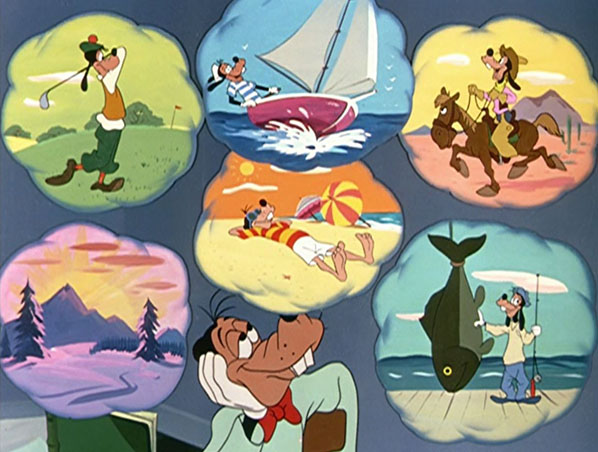
Two Weeks Vacation (Disney/RKO, Goofy, 10/31/52 – Jack Kinney, dir.) – Ah, the Disney gang did love their motoring. Goofy, in his “everyman” mode, demonstrates just how complicated the average road trip can get. Leaving his place of employment with a cheery “So long, slaves” to his fellow workers, Goofy hits the freeway for the wide open spaces. But his super speed is quickly reduced to a crawl by a double-wide trailer proceeding at a snail’s pace ahead of him. As he tries to find room to squeak his vehicle by for a pass, a baby bottle falls out the trailer’s window, giving the Goof a flat tire. He pulls into a “quaint, out of the way place” – the local auto garage. The klutzy mechanic (voiced by Flintstone-to-be Alan Reed, who doubles as narrator) ignores the obvious flat tire, tears apart everything under the hood, and tells Goof he needs a whole new motor. Completing the job, he sends Goofy on his way – having replaced everything but the flat tire – then slams the garage door shut with a sign indicating “Closed for two weeks.’ Goof winds up repairing the flat himself – as that pesky trailer passes him again. Getting back on the road, Goofy tries another pass, narrowly dodging a cloud of dust as the trailer’s occupant sweeps dirt out the trailer’s side door. Goofy waves a jeering “Ta ta” to the trailer, but fails to see an upcoming mountain curve, crashing through the guard rail. Goofy spends most of the evening with his car perched atop a high pine tree extending from the valley below.
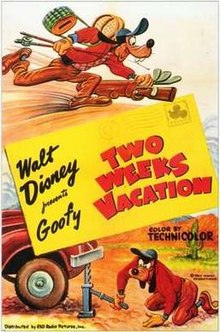 Back on the road again, Goofy looks for a place to rest. He spots a tall signpost with signage too dark to see. The only way he can illuminate it is to jack up the front of his car and turn on the headlights. One sign points back the way he came, reading “Last Chance Motel – 20 Mi.” The other, pointing onward ahead of him, reads, “Next Chance Motel – 500 Mi.” Goofy is forced to backtrack. He finds a string of motels, all indicating “No Vacancy”. Finally spotting one not yet filled, Goof is unable to reach its parking lot, as his car runs out of gas. And who should happen to roll in to take the last occupancy but the trailer! Now Goof pushes his car a mile to locate gas, but loses the vehicle when he encounters a steep grade. He chases the car down a winding mountain road, where it finally rolls to a stop at another out of the way motel still vacant (the car’s hood ornament ringing the night bell). Goofy happily rents a room, and enters what looks like the entrance of a cozy bungalow – but is in fact just a movie-style prop set, covering a run-down shack. Goofy will still take anything – until the headlight of an approaching train bears down on him just outside his window, vibrating him right out of bed and back into his car.
Back on the road again, Goofy looks for a place to rest. He spots a tall signpost with signage too dark to see. The only way he can illuminate it is to jack up the front of his car and turn on the headlights. One sign points back the way he came, reading “Last Chance Motel – 20 Mi.” The other, pointing onward ahead of him, reads, “Next Chance Motel – 500 Mi.” Goofy is forced to backtrack. He finds a string of motels, all indicating “No Vacancy”. Finally spotting one not yet filled, Goof is unable to reach its parking lot, as his car runs out of gas. And who should happen to roll in to take the last occupancy but the trailer! Now Goof pushes his car a mile to locate gas, but loses the vehicle when he encounters a steep grade. He chases the car down a winding mountain road, where it finally rolls to a stop at another out of the way motel still vacant (the car’s hood ornament ringing the night bell). Goofy happily rents a room, and enters what looks like the entrance of a cozy bungalow – but is in fact just a movie-style prop set, covering a run-down shack. Goofy will still take anything – until the headlight of an approaching train bears down on him just outside his window, vibrating him right out of bed and back into his car.
Where he gets gas, we’ll never know. But Goofy has decided to drive on through the night. His eyes alternate between popping and contracting as they attempt to adjust to oncoming headlights from approaching vehicles. Speaking of vehicles, never underestimate a good running gag. It’s the trailer again ahead, not only hogging the road, but with shadows on the blinds inside of a wild party in progress. Goof attempts to pass, and finds the party is wilder than expected – as there is no one at the wheel of the car pulling the group! (Well, Goof, you see what happens when you set a bad example yourself by doing the same thing 14 years earlier?) The pilotless vehicle careens menacingly, as Goofy attempts to outrun it. But Goof’s car hits a rock, bouncing him out of the driver’s seat and into the same seat of the trailer’s car, while his own vehicle gets left behind on the side of the road. Finally, the law takes its course, as a policeman instructs Goof to pull over. Goof gets the blame for everything – but is happy. He spends the rest of his vacation in a local jail cell, enjoying “good food, excellent service, and complete privacy.”
Barney’s Hungry Cousin (MGM, Barney Bear, 1/31/53 – Dick Lundy, dir.) – An influential cartoon, which seems to have set the template for series to follow from three different studios – two rivals, and the third being the successor in interest to the MGM legacy. We know something looks mighty familiar from the very first shot, as a sign welcomes us to “Jellystone National Park” – soon to be the well known home to baby boomers of studio veterans Hanna and Barbera’s famous Yogi Bear. Yep, this is where it all started. Our ersatz Yogi, the title character of the episode, does not yet wear a hat and tie, nor say “Hey Hey Hey” – but his instincts for picnic baskets are just as keen. From atop a tall tree, he watches the roads through a telescope, and spots “civilized” Barrney Bear driving into the park with a large basket in the car’s rear compartment – which Cousin’s eyes see with the subliminal imposition of the word “FOOD”. Cousin descends to the ground, and produces instant tables, barbecue, umbrellas, and sign reading “Free Picnic Grounds”.
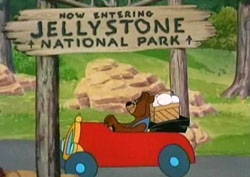 Just as quickly, he removes a string of signs from the nearby trees reading “Do Not Feed the Bears” – and buries them all in the ground. Barney is sucker for tonight, and brings his basket over to the picnic table. While Scott Bradley’s orchestra plays his favorite eating-music cue, “Sing Before Breakfast”, Barney raises a sausage to his lips with a fork. A split-second grab by a furry hand from under the table leaves Barney chewing on the empty fork tines. A further attempt to bring a sandwich into eating range is intercepted by the split-second appearance of Cousin’s head, leaving Barney to chomp on his own knuckles. Cousin now reveals himself, sniffing at the basket, and inhaling several more sandwiches. Barney grabs away one, but Cousin forms his tongue into a lasso and snares it back again. Now Cousin demonstrates a feat of magic with a donut. He covers same with a handkerchief – and suddenly, it disappears.
Just as quickly, he removes a string of signs from the nearby trees reading “Do Not Feed the Bears” – and buries them all in the ground. Barney is sucker for tonight, and brings his basket over to the picnic table. While Scott Bradley’s orchestra plays his favorite eating-music cue, “Sing Before Breakfast”, Barney raises a sausage to his lips with a fork. A split-second grab by a furry hand from under the table leaves Barney chewing on the empty fork tines. A further attempt to bring a sandwich into eating range is intercepted by the split-second appearance of Cousin’s head, leaving Barney to chomp on his own knuckles. Cousin now reveals himself, sniffing at the basket, and inhaling several more sandwiches. Barney grabs away one, but Cousin forms his tongue into a lasso and snares it back again. Now Cousin demonstrates a feat of magic with a donut. He covers same with a handkerchief – and suddenly, it disappears.
Where is it? Sliding down the bear’s throat in visible silhouette. Cousin next pulls a turkey from Barney’s basket. Barney is beginning to realize this means war, and produces a container of alum, sprinkling it on the bear’s lips to pucker them to size too small to eat the turkey. But Cousin has a simple solution – sprinkle the turkey with alum, too, shrinking the bird to convenient bite size. Next in the basket is a handful of cherries. Barney beats Cousin to this course, swallowing them. Cousin will not take this setback lying down, and bops Barney on the head, immobilizing him. Then, Cousin pulls Barney’s arm as if he were playing a slot machine. Barney’s eyes roll – and the images of two cherries settle into his eye sockets. Barney’s mouth falls open, delivering a jachpot of returned cherries. Cousin isn’t satisfied even with this result, and whaps Barney on the side of the head – causing the two cherries in his eyes to fall out too.
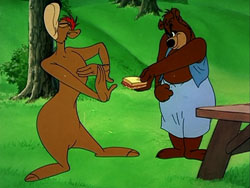 Barney knows he’s up against tough competition – and grabs his basket, hurrying back to the car and flooring the gas pedal for a hasty exit to another part of the park. But he’s not alone. As he attempts to retrieve a link of sausages from the basket, he finds Cousin chomping on the other end. Barney produces a firecracker, ties it to the end of the sausages, and waits until Cousin has downed the whole thing. But nothing happens. Barney steps up to Cousin, listens to his tummy but hears no action, then opens up Cousin’s moth to look inside. He is greeted by an explosive “Burp”, leaving Barney’s face charred, as Cousin takes his only line of dialogue in the film – “Pardon me.”
Barney knows he’s up against tough competition – and grabs his basket, hurrying back to the car and flooring the gas pedal for a hasty exit to another part of the park. But he’s not alone. As he attempts to retrieve a link of sausages from the basket, he finds Cousin chomping on the other end. Barney produces a firecracker, ties it to the end of the sausages, and waits until Cousin has downed the whole thing. But nothing happens. Barney steps up to Cousin, listens to his tummy but hears no action, then opens up Cousin’s moth to look inside. He is greeted by an explosive “Burp”, leaving Barney’s face charred, as Cousin takes his only line of dialogue in the film – “Pardon me.”
In another scene remembered by Hanna-Barbera (which actually director Lundy probably remembered from the Captain and the Kids’ “Petunia Natural Park”, Barney drives his car into the tunnel of a giant redwood, and drives out high above on a tree limb (a gag which would become part of the title sequence for the Yogi Bear show). As Barney tries to picnic in the trees, Cousin sets up a teeter-totter below, launching himself skyward by throwing a heavy iron weight onto the other end of the board. He again intercepts Barney’s sandwich, then falls back to the board, launching into the air the metal counterweight. Barney is narrowly missed by the weight, and decides not to wait for its downward fall, diving into the car and taking off again at super speed to a high mountainous region of the park. No sooner does he set up camp again than the weight, which has miraculously followed, bashes Barney into the ground, leaving only his hand entended from the ground, holding a sandwich. Cousin appears, and uses Barney’s hand as a seat while enjoying another lunch.
Barney eventually outraces Cousin across a mountain rope bridge, cutting the bridge behind him to preent Cousin from following. Cousin produces a kid’s school slate and chalk, and concocts a diagram for a swing across the chasm by rope from a tree, measuring distance as 23 feet. Tying a rope to a tree, he performs the Tarzan stunt – and bashes face-first into the opposite canyon wall (for his only setback in the picture). Returning battered to the original cliff, he corrects his math error to “25 feet”, then successfully swings to clear everything off Barney’s picnic blanket. Barney scoots out of the scene again, and hides inside of one of two adjoining outdoor telephone booths. Attempting to eat a sandwich inside, Barney is interrupted by the phone ringing – and the head of Cousin appears from the phone’s mouthpice to nab the eats again. Barney pokes his head outside, to see the confusing sight of Cousin’s body in the second phone booth, with his head in the other (despite a visible gap of space between the two booths). Barney drags Cousin out of the mouthpiece, and uses the booth to devise a Houdini escape peril – chaining Cousin up, boarding and locking him inside the booth, then pushing the booth off a cliff.
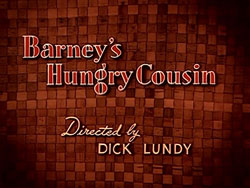 With graceful dexterity, Cousin slips neatly out of the chains, produces a hammer and lockpick to remove the boards and lock, and steps out of the booth a split second before it crashes into the ground, reduced to rubble. Barney is now down to his last sandwich – and wouldn;t you know it, finds Cousin right there, substituting in place of his chair. Why fight it? Barney hands the last sandwich to Cousin. But Cousin is a bear of principle, and won’t accept what he hasn’t worked for. In fact, he darts to where he had buried the “Do Not Feed the Bears” signs, and posts them all up again, then blows a whistle to summon the rangers to arrest the rule-breaker. Barney is thrown into the paddy wagon of the Anti-Bear Feeding Patrol. As he is driven away to the calaboose, Barney produces from his pocket a little extra he’d saved for emergency – a large lollipop in his vest pocket. But a familiar hand reaches into the cell from the driver’s window, taking away this last souce of calories. Barney’s driver is of course, Cousin, who slurps away at this last prize for the iris out.
With graceful dexterity, Cousin slips neatly out of the chains, produces a hammer and lockpick to remove the boards and lock, and steps out of the booth a split second before it crashes into the ground, reduced to rubble. Barney is now down to his last sandwich – and wouldn;t you know it, finds Cousin right there, substituting in place of his chair. Why fight it? Barney hands the last sandwich to Cousin. But Cousin is a bear of principle, and won’t accept what he hasn’t worked for. In fact, he darts to where he had buried the “Do Not Feed the Bears” signs, and posts them all up again, then blows a whistle to summon the rangers to arrest the rule-breaker. Barney is thrown into the paddy wagon of the Anti-Bear Feeding Patrol. As he is driven away to the calaboose, Barney produces from his pocket a little extra he’d saved for emergency – a large lollipop in his vest pocket. But a familiar hand reaches into the cell from the driver’s window, taking away this last souce of calories. Barney’s driver is of course, Cousin, who slurps away at this last prize for the iris out.
A brilliant feast of deft comic timing, and my personal favorite of Lundy’s output for the studio. As mentioned, the film was the obvious inspiration for H-B’s later Yogi Bear. However, it seems to be a further direct influence upon Jack Hannah at Disney, who later in the year would introduce his new foil for Donald Duck, Humphrey Bear. While the resemblance to Humphrey may not have been as directly apparent in the Duck’s first pairing with the character, Rugged Bear (10/23/53), nearly the whole basic setup from the Lundy film is lifted for Humphrey’s second appearance, Grin and Bear It, to be discussed in next week’s article. And the influence did not stop there – as Hannah would eventually transition to Walter Lantz studios, bringing the Humphrey character with him under the new moniker, “Fatso Bear” – and reprising a similar food-motivated setup for the film Hunger Strife (8/19/60). Yes, a solid idea can travel a good long way down the trail.
Here’s the film via a Japanese You Tube: Click Here.
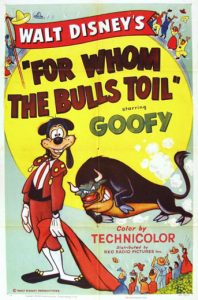 For Whom the Bulls Toil (Disney/RKO, Goofy, 5/9/53, Jack Kinney, dir.) – Kinney seemed to be in the middle of a conscience crisis about this time. He had converted Goofy for a few seasons into an everyman, and made him a father too, as previously seen. He had given the Goof an urban wardrobe, and for a time, even abandoned the voice of Pinto Colvig to give the Goof an “average” voice without the “Hyulk”s. But once in a while, Kinney would still remember the character’s roots, and allow him to revert to form. This episode ranks as one of the last “classic mode” Goofs, with the character becoming the country hick again, overalls and all, and complete with Model T jalopy. Kinney was also in a short period of dressing up his product. with the assistance of musical celebrities. Three of his films from this period include surprise musical cameos receiving screen billing. “Hello Aloha” (which only missed the cut of these articles because Goofy’s move to the islands is permanent rather than a mere vacation) featured Harry Owens and his Orchestra. “How To Dance” featured Disney’s in-house Dixieland attraction, Ward Kimball’s Firehouse Five Plus Two. And in this episode, Mexican concert trumpeter Rafael Mendez receives title billing and is heard throughout to marvelous effect. Add to this a special clearance for an eight-minute running time (when average studio releases were restricted to six and a half), and the result is something special.
For Whom the Bulls Toil (Disney/RKO, Goofy, 5/9/53, Jack Kinney, dir.) – Kinney seemed to be in the middle of a conscience crisis about this time. He had converted Goofy for a few seasons into an everyman, and made him a father too, as previously seen. He had given the Goof an urban wardrobe, and for a time, even abandoned the voice of Pinto Colvig to give the Goof an “average” voice without the “Hyulk”s. But once in a while, Kinney would still remember the character’s roots, and allow him to revert to form. This episode ranks as one of the last “classic mode” Goofs, with the character becoming the country hick again, overalls and all, and complete with Model T jalopy. Kinney was also in a short period of dressing up his product. with the assistance of musical celebrities. Three of his films from this period include surprise musical cameos receiving screen billing. “Hello Aloha” (which only missed the cut of these articles because Goofy’s move to the islands is permanent rather than a mere vacation) featured Harry Owens and his Orchestra. “How To Dance” featured Disney’s in-house Dixieland attraction, Ward Kimball’s Firehouse Five Plus Two. And in this episode, Mexican concert trumpeter Rafael Mendez receives title billing and is heard throughout to marvelous effect. Add to this a special clearance for an eight-minute running time (when average studio releases were restricted to six and a half), and the result is something special.
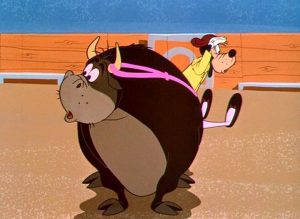 A brief interlude at the bull arena opens the film. An unusual piece of product placement appears in the first shot, where a Mexican version of the Goodyear blimp appears over the arena – shaped and labeled in the wrappings of an “XLNT” Tamale. (Any copies of the contract releases for this gag still exist in the Disney morgue?) But our scene quickly shifts to the desert outside of town, where the traditions of the bull ring are demonstrated to mean nothing to the average American tourist. Did we say average? Goofy is anything but. The progress of his Model T is brought to a standstill by a bovine seated in the road. Goof presumes it’s a cow – I guess all those years on the farm still haven’t taught him to distinguish. The local populace, however, knows well it’s a killer bull, and as Goofy steps out of the car to confront the beast, a local beckons the others to come see the “loco Americano”. Amid mutterings from the crowd of “estupido”, “idiota”, and “imbecile”, Goofy attempts to shoo the animal away, push him with the car, and pry him off the ground with a stick. This being hard work, he mops his brow with a red handkerchief. The bull’s nose ring raises like a gunner’s sight at seeing the flash of red, and the bull rises for a charge. Goof puts the handkerchief back in his hip pocket, causing the bull to pass him in toreador style. A few shots of animation are borrowed from “Ferdinand the Bull” to allow the bull to collide with several other cows, and make wide turns through walls to charge Goofy again and again. But Goof, who thinks he “scared her”, calmly sets about cranking up his car, always ducking out of the way just as the bull passes. The crowd cheers him on with “Magnifico”. Another unsuccessful charge leaves the bull with Goofy’s car door stuck to his horns, with Goofy prying it off, commenting “Dog gone cow.” He finally gets the motor started, and leaves a cloud of exhaust fumes behind, making the bull gasp for breath and fall exhausted upon the road. Goofy continues on his way, hardly noticing the country folk’s cheers continuing to echo in the background.
A brief interlude at the bull arena opens the film. An unusual piece of product placement appears in the first shot, where a Mexican version of the Goodyear blimp appears over the arena – shaped and labeled in the wrappings of an “XLNT” Tamale. (Any copies of the contract releases for this gag still exist in the Disney morgue?) But our scene quickly shifts to the desert outside of town, where the traditions of the bull ring are demonstrated to mean nothing to the average American tourist. Did we say average? Goofy is anything but. The progress of his Model T is brought to a standstill by a bovine seated in the road. Goof presumes it’s a cow – I guess all those years on the farm still haven’t taught him to distinguish. The local populace, however, knows well it’s a killer bull, and as Goofy steps out of the car to confront the beast, a local beckons the others to come see the “loco Americano”. Amid mutterings from the crowd of “estupido”, “idiota”, and “imbecile”, Goofy attempts to shoo the animal away, push him with the car, and pry him off the ground with a stick. This being hard work, he mops his brow with a red handkerchief. The bull’s nose ring raises like a gunner’s sight at seeing the flash of red, and the bull rises for a charge. Goof puts the handkerchief back in his hip pocket, causing the bull to pass him in toreador style. A few shots of animation are borrowed from “Ferdinand the Bull” to allow the bull to collide with several other cows, and make wide turns through walls to charge Goofy again and again. But Goof, who thinks he “scared her”, calmly sets about cranking up his car, always ducking out of the way just as the bull passes. The crowd cheers him on with “Magnifico”. Another unsuccessful charge leaves the bull with Goofy’s car door stuck to his horns, with Goofy prying it off, commenting “Dog gone cow.” He finally gets the motor started, and leaves a cloud of exhaust fumes behind, making the bull gasp for breath and fall exhausted upon the road. Goofy continues on his way, hardly noticing the country folk’s cheers continuing to echo in the background.
One of the witnesses to the spectacle runs for a telephone, and calls ahead to the city, advising of the “matador Americano” about to arrive in “new Model T Ford” (an interesting socioeconomic comment on Mexican ideas of standards of modern living). In Spanish, he builds Goofy up as more stupendous than Manolete. At a radio station in town, a trio’s rendition of the latest hit, “On Top Of Old Popocateptl” is interrupted by the news flash of the greatest of all matadors coming to their bull ring. The Goof enters town to an adoring public. “Friendly folk”, he observes. The crowd ushers him out of his car, then into the center of a huddle, into which are brought the garments of a glittering matador’s costume. Goofy emerges from the circle in a bright yellow outfit and flashing red cape, and concludes the only logical explanation: “Halloween!”
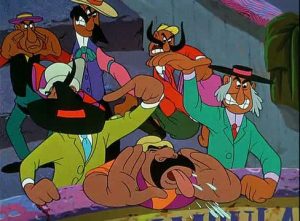 The arena is packed to capacity. Goofy is led to the matador’s entrance, and wanders out to center as the cheers reach their height. “Well, this is nice”, says Goof, still oblivious to why he is so popular, and bows a grateful bow to the crowd. Just then, a stray newspaper page blows into the arena, landing at Goofy’s feet. On it, his picture, referring to him as “Matador”. That word Goofy understands. “A fighter of the bulls? Me? Oh, NO!!!!” He attempts to escape, but runs right into the bull’s pen, as the crowd gasps. Inside the darkened pen, Goofy gets a whiff of a familiar aroma – “Must be a dairy.” He strikes a match – and finds himself face to face with the same bull he just wrangled with. Giving his signature scream “Ya hoo hoo hoo hooey!”, Goof bursts back out the pen door, and the bull does the same. The bull scans the arena, and finds Goof hiding atop the highest flagpole. The crowd wants a show, and pulls Goofy down, tossing him back into the arena. The bull charges, and Goof hides behind one of the wooden target barriers fringing the arena. The bull’s horns plant themselves in the boards, then the bull picks up the entire barrier, with Goofy clinging to the other side, and continues his charge, progressively driving Goofy and the barrier into the ground – until they appear to have formed a grave and headstone. The crowd reacts accordingly, lowering the arena flags to half mast. But as the bull pulls loose, Goofy merely pushes back the barrier like a hinged door, and emerges unharmed as if stepping out of a tunnel. A pass of the bull causes Goofy’s pants to fall, exposing his polka dot shorts.
The arena is packed to capacity. Goofy is led to the matador’s entrance, and wanders out to center as the cheers reach their height. “Well, this is nice”, says Goof, still oblivious to why he is so popular, and bows a grateful bow to the crowd. Just then, a stray newspaper page blows into the arena, landing at Goofy’s feet. On it, his picture, referring to him as “Matador”. That word Goofy understands. “A fighter of the bulls? Me? Oh, NO!!!!” He attempts to escape, but runs right into the bull’s pen, as the crowd gasps. Inside the darkened pen, Goofy gets a whiff of a familiar aroma – “Must be a dairy.” He strikes a match – and finds himself face to face with the same bull he just wrangled with. Giving his signature scream “Ya hoo hoo hoo hooey!”, Goof bursts back out the pen door, and the bull does the same. The bull scans the arena, and finds Goof hiding atop the highest flagpole. The crowd wants a show, and pulls Goofy down, tossing him back into the arena. The bull charges, and Goof hides behind one of the wooden target barriers fringing the arena. The bull’s horns plant themselves in the boards, then the bull picks up the entire barrier, with Goofy clinging to the other side, and continues his charge, progressively driving Goofy and the barrier into the ground – until they appear to have formed a grave and headstone. The crowd reacts accordingly, lowering the arena flags to half mast. But as the bull pulls loose, Goofy merely pushes back the barrier like a hinged door, and emerges unharmed as if stepping out of a tunnel. A pass of the bull causes Goofy’s pants to fall, exposing his polka dot shorts.
On the next pass, the bull hooks Goofy’s suspenders. The bull spins his head around, causing Goofy to stretch the suspenders to the limit and be twirled around the bull ring, taking out several sections of the crowd as he plows into them. But the suspenders ultimately wind around the bull, dragging Goofy back, until he is again nose to nose with the animal. Goofy stretches things to the limit again, trying to run outside for his car. But the suspenders snap him back into the ring – this time with such force that his impact with the bull not only knocks the bull unconscious against the arena wall, but pushes the whole arena a full city block across town. Goofy is declared the winner, and all forms of hats and sombreros are thrown into the ring (with naive Goofy trying to help by picking up all the mislaid headwear). In the final shot, a narrator states that the turista will take home a better understanding of matadors and brave bulls – as Goofy encounters another seated bovine in the road. Without further questions, Goofy slips his car around the animal, then floors the gas pedal to disappear over the hill. The animal stands up – and this time it really is a harmless cow!
In a strange coda to this production, the film was singled out for commemoration in the Little Golden Records series by Simon and Schuster publishers, in a two-sided release entitled “Goofy the Toreador”. The cover artwork for the single is wonderful, appearing to be created by the original artists who worked on the film. However, the record is a total disappointment, consisting on side one of a new lyric set to Bizet’s standard Toreador March from Carmen, with side two just an instrumental repetition of the same piece. And Pinto Colvig doesn’t even make the recording date (despite several appearances on other issues for the label), being impersonated by an unknown who doesn’t get the idea of the voice at all. Perhaps Golden was in a hurry to get this out while the film was still fresh in audiences’ memories – possibly the only explanation for the uncharacteristically shoddy production values.
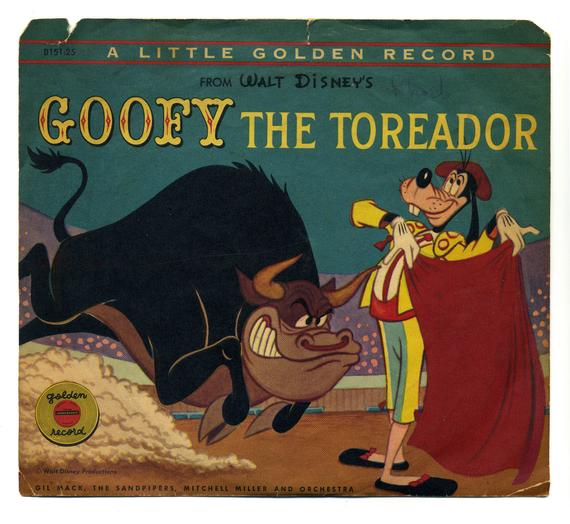
Donald Duck and his nephews’ Florida Everglades vacation in Don’s Fountain of Youth (Disney/RKO, 5/30/53, Jack Hannah, dir.) has been thoroughly discussed in my previous post “Happy Henfruit (Part 7)”, to which the reader is directed for greater details. Briefly, Donald becomes fed up with the kids’ insistence on reading comic books rather than enjoying the wondrous scenery, and pulls a mean trick to get their attention – taking a dip in a spring mistaken for the Fountain of Youth, and passing it off as the real thing. In baby bonnet, Donald behaves like a spoiled brat to teach the kids a lesson, but winces when the kids procure a switch to administer a little discipline. He magnifies the “effects” of the fountain by placing an egg under his baby bonnet, oblivious to the fact that a mother alligator will object to the eggnapping. The kids try to protect the egg, while Donald dodges the gaping jaws of Mama. He and the kids finally make an exit, and Mama is only able to bond with her new offspring by imitating Donald’s “Quack Quack Quack.”
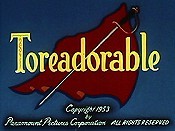 Toreadorable (Paramount/Famous, Popeye – 6/12/53 – Seymour Keneitel, dir.) – At the “Chili Bowl” arena, bullfight fans congregate, as turistas Popeye and Olive emerge from a Mexican subway – actually a donkey cart with overhead handles for standing room – with Olive eagerly anticipating seeing her first bullfight. Of course, today’s toreador is the world’s champion from Brooklyn, Señor Bluto. As he sees Olive in the stands, Bluto’s eyes turn into fire alarm bells with clappers ringing them from either side. He dedicates to her the first bull while Popeye remains unimpressed. Bluto borrows the old gag from Bugs Bunny in Bully For Bugs of concealing an anvil behind his cape for the bull to run into. As the bull’s horns unscrew from the impact, Bluto picks up the bull bodily and jumps rope with his torso, then hurls the bull acros the arena. “Skippin’ ropes is for dopes”, says Popeye, and produces his spinach can for a first dose. Popeye coaxes the bull to charge with a red handkerchief, then ducks into his own trousers for the bull to pass over him. But the bull gets hold of Popeye’s suspenders with his horns, and pulls Popeye’s feet with his tail, forming a live slingshot, which hurls Popeye up onto a flagpole. Popeye quickly reverses the trick, bending the flagpole back down into the arena with his weight, where its top lands smack upon the bull’s horns, each of which spear into the wood. Then, the flagpole springs back to upright position, taking the bull with it, to fly as a pennant from its lofty height. Olive cheers Popeye, while Bluto realizes this runt’s too good.
Toreadorable (Paramount/Famous, Popeye – 6/12/53 – Seymour Keneitel, dir.) – At the “Chili Bowl” arena, bullfight fans congregate, as turistas Popeye and Olive emerge from a Mexican subway – actually a donkey cart with overhead handles for standing room – with Olive eagerly anticipating seeing her first bullfight. Of course, today’s toreador is the world’s champion from Brooklyn, Señor Bluto. As he sees Olive in the stands, Bluto’s eyes turn into fire alarm bells with clappers ringing them from either side. He dedicates to her the first bull while Popeye remains unimpressed. Bluto borrows the old gag from Bugs Bunny in Bully For Bugs of concealing an anvil behind his cape for the bull to run into. As the bull’s horns unscrew from the impact, Bluto picks up the bull bodily and jumps rope with his torso, then hurls the bull acros the arena. “Skippin’ ropes is for dopes”, says Popeye, and produces his spinach can for a first dose. Popeye coaxes the bull to charge with a red handkerchief, then ducks into his own trousers for the bull to pass over him. But the bull gets hold of Popeye’s suspenders with his horns, and pulls Popeye’s feet with his tail, forming a live slingshot, which hurls Popeye up onto a flagpole. Popeye quickly reverses the trick, bending the flagpole back down into the arena with his weight, where its top lands smack upon the bull’s horns, each of which spear into the wood. Then, the flagpole springs back to upright position, taking the bull with it, to fly as a pennant from its lofty height. Olive cheers Popeye, while Bluto realizes this runt’s too good.
As the bull pries his horns loose from the pole and charges again, Popeye prepares for another exhibition of spinach-powered strength, producing the can for another dose. Bluto intercepts the meal by tossing a large sombrero over Popeye’s head. The bull leaps on top of Popeye, flattening him to the ground with his head sticking out the center of the sombrero, while the bull performs a hat dance around its brim. But the spinach can is not out of reach of the suction of Popeye’s pipe, and a quick ingestion of the green allows Popeye to smack the bull down to a seated position, string the bull’s tail to his head, and play a solo upon the bull as if playing a slap-bass. Then, with a flick of the wrist, Popeye spins the bull like a top, back into the bull pen. Bluto’s not through yet, and as the bull begins tearing the pen door apart by using his horns as a can opener, Bluto substitutes for Popeye’s spinach a can full of Mexican jumping beans.
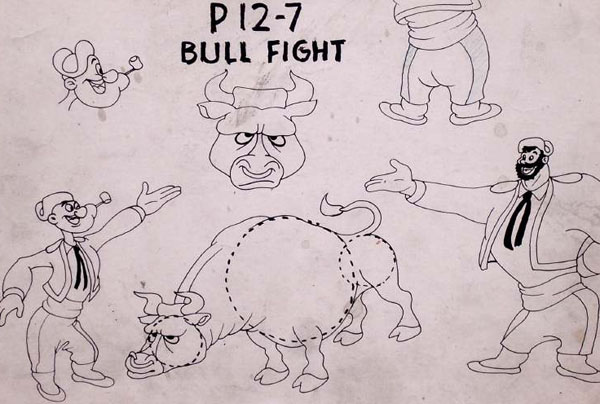
Unsuspecting Popeye downs the can, and develops a severe case of internal bounces – the first of which actually saves his neck from a direct-hit goring by bouncing him over the bull’s head. The miss causes the bull to crash into the arena wall and blunt his horns – a problem quickly solved by inserting his horn tips into a pencil sharpener. Back to Popeye, still bouncing. The bull catches him on his horns, launching the sailor over the arena wall and into the wagon of a produce vendor in town. Of course, the vendor specializes in “el spinachio”. Bluto meanwhile tries to make time with Olive, and when she won’t deliver the kisses, attempts to change her mind by using her and her red dress as the cape to dodge the bull’s passes. Popeye gets his dose of the local crop, instantly transforms into a toreador’s outfit, and uses a jet of flame from his pipe to rocket himself back into the arena. With a mighty sock, he sends Bluto flying straight at the bull. Bluto lands with such impact on the bull’s head that the bull’s horns are bent to form handcuffs around Bluto’s wrists. The bull continues blindly charging, carrying Bluto backwards. Popeye lifts the stands of the arena, allowing the bull to charge out into the desert. There, the bull continues his mad run, straight through patches of local cactus, each cactus’s needles neatly perforating Bluto’s rear end, for a run that will probably continue as far as there is desert. As the crowd shouts “viva” both to Popeye and the spinach, Popeye holds up the red cape to conceal a kiss between himself and Olive, seen in silhouette against the red cape, which assumes the shape of a heart.
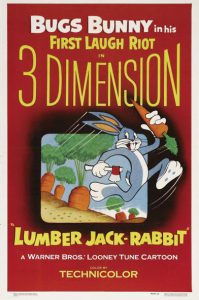 Lumber Jack Rabbit (Warner, Bugs Bunny, 9/25/53 – Charles M. (Chuck) Jones, dir) – This cartoon hardly feels like it belongs in this trail, except for the passing reference by Bugs as he settles down to rest with his bindle stick, “Ah, me. Good old vacation time.” This visit to the territory of Paul Bunyan, the studio’s only cartoon in 3-D, was overall a disappointment in a number of ways. First, the visuals just didn’t seem to be played to full effect. I saw the film in 35mm at a festival at Hollywood’s Egyptian theatre, on a program featuring the surviving 3D cartoons from all the major (and a few minor) studios – and it frankly came out the flattest-looking of everything on the program. To add insult to injury, as it was first on the bill, one projector seemed to light up late, ruining the effect of the Warner shield zoom on the opening. The only two shots that seemed to give any real feeling of depth were the shot when Bugs looks across an expanse to see the giant dog tag of Paul Bunyan’s dog, and a very brief shot within the dog’s fur, where the dog’s hairs run in opposite directions at different depths from the camera. In contrast, the two studios who really had the process down were the smallest of the majors – Paramount, with excellent work on its Popeye and Casper space outings, and of all people, Walter Lantz, who seemed to have taken the time to come up with a cel mounting system looking similar in style to Max Fleischer’s turntable camera, allowing for great depth in the scenic backgrounds (sometimes appearing to have horizons about forty feet off in the distance). For all its supposed effort in disrupting studio production to make the conversion to 3-D, this film just did not seem capable of holding its own among the competitors, and must have been a tremendous disillusionment to fans and animators alike.
Lumber Jack Rabbit (Warner, Bugs Bunny, 9/25/53 – Charles M. (Chuck) Jones, dir) – This cartoon hardly feels like it belongs in this trail, except for the passing reference by Bugs as he settles down to rest with his bindle stick, “Ah, me. Good old vacation time.” This visit to the territory of Paul Bunyan, the studio’s only cartoon in 3-D, was overall a disappointment in a number of ways. First, the visuals just didn’t seem to be played to full effect. I saw the film in 35mm at a festival at Hollywood’s Egyptian theatre, on a program featuring the surviving 3D cartoons from all the major (and a few minor) studios – and it frankly came out the flattest-looking of everything on the program. To add insult to injury, as it was first on the bill, one projector seemed to light up late, ruining the effect of the Warner shield zoom on the opening. The only two shots that seemed to give any real feeling of depth were the shot when Bugs looks across an expanse to see the giant dog tag of Paul Bunyan’s dog, and a very brief shot within the dog’s fur, where the dog’s hairs run in opposite directions at different depths from the camera. In contrast, the two studios who really had the process down were the smallest of the majors – Paramount, with excellent work on its Popeye and Casper space outings, and of all people, Walter Lantz, who seemed to have taken the time to come up with a cel mounting system looking similar in style to Max Fleischer’s turntable camera, allowing for great depth in the scenic backgrounds (sometimes appearing to have horizons about forty feet off in the distance). For all its supposed effort in disrupting studio production to make the conversion to 3-D, this film just did not seem capable of holding its own among the competitors, and must have been a tremendous disillusionment to fans and animators alike.
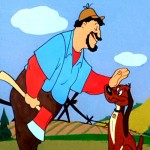 Plotwise, Bugs wanders into Bunyan’s garden, and settles to rest against the top of a giant carrot in the ground. “Strange, I keep smelling carrots.” Scratching at the huge orange mound behind him, he tastes his finger. “Holy Eureka! I’ve discovered a carrot mine.” He sets up a series of mine carts and tunnels, and begins harvesting. Meanwhile, Paul Bunyan’s dog (Smidgen, weight 4,500 tons, height 124 feet, 6 inches), pulls up the carrot Bugs is mining in. Seeing his dog tag, Bugs thinks someone has erected a billboard – then looks down to see clouds below him. Bugs climbs upon the dog’s nose, and delivers his best line (which in a stronger cartoon might have been remembered as classic): “I’ll be scared later. Right now I’m too mad.” His attempts to confront or evade the dog involve him in brief perils inside a moose call, in the barrel of a pistol, and inside an apple. He finally makes friends with the dog when it develops that Bugs can scratch the dog’s “sweet spot” to satisfy his itching better than Smidgen can. Smidgen responds with giant licks, but Bugs merely gets rid of the pest by sending him off to visit a nearby giant redwood. An ending too sudden, too weak, and dooming the film to the ranking in studio history of a third-string filler.
Plotwise, Bugs wanders into Bunyan’s garden, and settles to rest against the top of a giant carrot in the ground. “Strange, I keep smelling carrots.” Scratching at the huge orange mound behind him, he tastes his finger. “Holy Eureka! I’ve discovered a carrot mine.” He sets up a series of mine carts and tunnels, and begins harvesting. Meanwhile, Paul Bunyan’s dog (Smidgen, weight 4,500 tons, height 124 feet, 6 inches), pulls up the carrot Bugs is mining in. Seeing his dog tag, Bugs thinks someone has erected a billboard – then looks down to see clouds below him. Bugs climbs upon the dog’s nose, and delivers his best line (which in a stronger cartoon might have been remembered as classic): “I’ll be scared later. Right now I’m too mad.” His attempts to confront or evade the dog involve him in brief perils inside a moose call, in the barrel of a pistol, and inside an apple. He finally makes friends with the dog when it develops that Bugs can scratch the dog’s “sweet spot” to satisfy his itching better than Smidgen can. Smidgen responds with giant licks, but Bugs merely gets rid of the pest by sending him off to visit a nearby giant redwood. An ending too sudden, too weak, and dooming the film to the ranking in studio history of a third-string filler.
Vacation season is drawing to a close. We’ll give it a final go for this year next week, then on to new horizons.


 Charles Gardner is an animation enthusiast who toils by day as a member of LA Law – but by nights and weekends indulges in classic jazz and ragtime as a performer; and studies classic Hollywood cartoons… maybe a little too much.
Charles Gardner is an animation enthusiast who toils by day as a member of LA Law – but by nights and weekends indulges in classic jazz and ragtime as a performer; and studies classic Hollywood cartoons… maybe a little too much.


































































































































































The cafeteria scene with Sylvester is one of my favorites.
The Dick Lundy Barney bear cartoons were some of the funniest produced.
He was a very underrated director.
The mouse hula girl in the magazine ad isn’t the weirdest thing about that scene in “Seasick Sailors”. When Roquefort sees the ad, the orchestra plays a phrase from the hymn “How Great Thou Art” (corresponding to the line “Then sings my soul, my saviour God, to thee”). You don’t hear a lot of hymns in old cartoons, and some people might have considered its inclusion in this context a form of blasphemy.
“Barney’s Hungry Cousin” opens with a passage from Wagner’s Overture to “Rienzi”, the same overture heard at the end of “Bully for Bugs”. Speaking of the latter (Warner Bros., Bugs Bunny, 8/8/53 — Chuck Jones, dir.), it probably belongs in this post, as it premiered the month before “Lumber Jack Rabbit”. Bugs is on his way to the Coachella Valley carrot festival — too far from his home in Hollywood for a mere day trip — but winds up in a Mexican bullring after having missed the left turn in Albuquerque. I doubt any readers will require a blow-by-blow of what follows.
There’s also “Plutopia” (Disney/RKO, Pluto, 18/5/51 — Charles Nichols, dir.). Mickey is on vacation at Camp Utopia, “the sportsman’s paradise”, where Pluto is thrilled to have lots of trees to sniff, a fat cat to chase, and a comfy bed in the cabin to bounce on. Unfortunately, it turns out that dogs are not allowed in the cabins and must be kept leashed and muzzled at all times; so Mickey, a stickler for the rules, is forced to leave Pluto bound and gagged on the doorstep. The cat takes advantage of the situation by eating Pluto’s dinner, pushing his bone out of reach, and — the ultimate indignity — using the poor dog as a pillow.
The night Pluto dreams that he has passed through the fire-hydrant gates of Plutopia, where all his wishes are fulfilled. Here the cat is a masochistic servant, who erupts in paroxysms of joy whenever Pluto bites him, and literally becomes suicidal when Pluto does not. The cat begs to be bitten and abused, and when Pluto obliges, he is rewarded with sausages, steaks, roast ducks and other delicacies. Pluto wakes from his dream as Mickey removes the muzzle before breakfast. But when Pluto nips his sleeping companion on the tail, the cat does not, as expected, serve him his morning meal, but instead turns into a whirling dust cloud of teeth and claws; and even Mickey gets pulled into the raging vortex. “Wha’ hoppen?” he asks on the iris out. A weak ending, but the cartoon is still worth seeing if only for the bizarre masochism of the cat in the dream sequence.